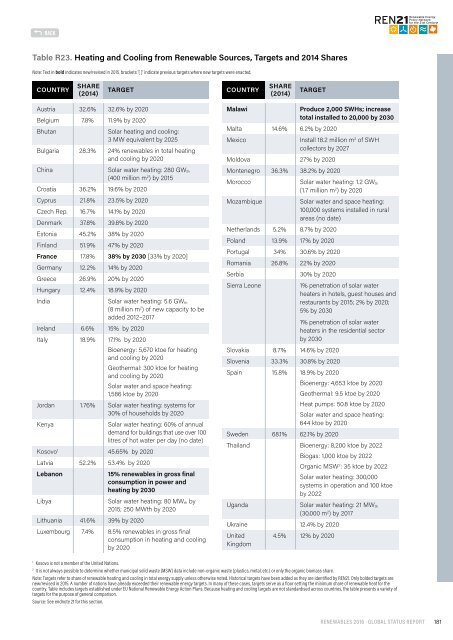2j7YOwO
2j7YOwO
2j7YOwO
Create successful ePaper yourself
Turn your PDF publications into a flip-book with our unique Google optimized e-Paper software.
Table R23. Heating and Cooling from Renewable Sources, Targets and 2014 Shares<br />
Note: Text in bold indicates new/revised in 2015, brackets ‘[ ]’ indicate previous targets where new targets were enacted.<br />
COUNTRY<br />
SHARE<br />
(2014)<br />
TARGET<br />
COUNTRY<br />
SHARE<br />
(2014)<br />
TARGET<br />
Austria 32.6% 32.6% by 2020<br />
Belgium 7.8% 11.9% by 2020<br />
Bhutan<br />
Solar heating and cooling:<br />
3 MW equivalent by 2025<br />
Bulgaria 28.3% 24% renewables in total heating<br />
and cooling by 2020<br />
China<br />
Solar water heating: 280 GW th<br />
(400 million m 2 ) by 2015<br />
Croatia 36.2% 19.6% by 2020<br />
Cyprus 21.8% 23.5% by 2020<br />
Czech Rep. 16.7% 14.1% by 2020<br />
Denmark 37.8% 39.8% by 2020<br />
Estonia 45.2% 38% by 2020<br />
Finland 51.9% 47% by 2020<br />
France 17.8% 38% by 2030 [33% by 2020]<br />
Germany 12.2% 14% by 2020<br />
Greece 26.9% 20% by 2020<br />
Hungary 12.4% 18.9% by 2020<br />
India<br />
Solar water heating: 5.6 GW th<br />
(8 million m 2 ) of new capacity to be<br />
added 2012–2017<br />
Ireland 6.6% 15% by 2020<br />
Italy 18.9% 17.1% by 2020<br />
Bioenergy: 5,670 ktoe for heating<br />
and cooling by 2020<br />
Geothermal: 300 ktoe for heating<br />
and cooling by 2020<br />
Solar water and space heating:<br />
1,586 ktoe by 2020<br />
Jordan 1.76% Solar water heating: systems for<br />
30% of households by 2020<br />
Kenya<br />
Solar water heating: 60% of annual<br />
demand for buildings that use over 100<br />
litres of hot water per day (no date)<br />
Kosovo 1 45.65% by 2020<br />
Latvia 52.2% 53.4% by 2020<br />
Lebanon<br />
15% renewables in gross final<br />
consumption in power and<br />
heating by 2030<br />
Libya<br />
Solar water heating: 80 MW th by<br />
2015; 250 MWth by 2020<br />
Lithuania 41.6% 39% by 2020<br />
Luxembourg 7.4% 8.5% renewables in gross final<br />
consumption in heating and cooling<br />
by 2020<br />
Malawi<br />
Produce 2,000 SWHs; increase<br />
total installed to 20,000 by 2030<br />
Malta 14.6% 6.2% by 2020<br />
Mexico<br />
Install 18.2 million m 2 of SWH<br />
collectors by 2027<br />
Moldova 27% by 2020<br />
Montenegro 36.3% 38.2% by 2020<br />
Morocco<br />
Solar water heating: 1.2 GW th<br />
(1.7 million m 2 ) by 2020<br />
Mozambique<br />
Solar water and space heating:<br />
100,000 systems installed in rural<br />
areas (no date)<br />
Netherlands 5.2% 8.7% by 2020<br />
Poland 13.9% 17% by 2020<br />
Portugal 34% 30.6% by 2020<br />
Romania 26.8% 22% by 2020<br />
Serbia 30% by 2020<br />
Sierra Leone<br />
1% penetration of solar water<br />
heaters in hotels, guest houses and<br />
restaurants by 2015; 2% by 2020;<br />
5% by 2030<br />
1% penetration of solar water<br />
heaters in the residential sector<br />
by 2030<br />
Slovakia 8.7% 14.6% by 2020<br />
Slovenia 33.3% 30.8% by 2020<br />
Spain 15.8% 18.9% by 2020<br />
Bioenergy: 4,653 ktoe by 2020<br />
Geothermal: 9.5 ktoe by 2020<br />
Heat pumps: 50.8 ktoe by 2020<br />
Solar water and space heating:<br />
644 ktoe by 2020<br />
Sweden 68.1% 62.1% by 2020<br />
Thailand Bioenergy: 8,200 ktoe by 2022<br />
Biogas: 1,000 ktoe by 2022<br />
Organic MSW 2 : 35 ktoe by 2022<br />
Solar water heating: 300,000<br />
systems in operation and 100 ktoe<br />
by 2022<br />
Uganda<br />
Solar water heating: 21 MW th<br />
(30,000 m 2 ) by 2017<br />
Ukraine 12.4% by 2020<br />
United<br />
Kingdom<br />
4.5% 12% by 2020<br />
1<br />
Kosovo is not a member of the United Nations.<br />
2<br />
It is not always possible to determine whether municipal solid waste (MSW) data include non-organic waste (plastics, metal, etc.) or only the organic biomass share.<br />
Note: Targets refer to share of renewable heating and cooling in total energy supply unless otherwise noted. Historical targets have been added as they are identified by REN21. Only bolded targets are<br />
new/revised in 2015. A number of nations have already exceeded their renewable energy targets. In many of these cases, targets serve as a floor setting the minimum share of renewable heat for the<br />
country. Table includes targets established under EU National Renewable Energy Action Plans. Because heating and cooling targets are not standardised across countries, the table presents a variety of<br />
targets for the purpose of general comparison.<br />
Source: See endnote 21 for this section.<br />
RENEWABLES 2016 · GLOBAL STATUS REPORT<br />
181



